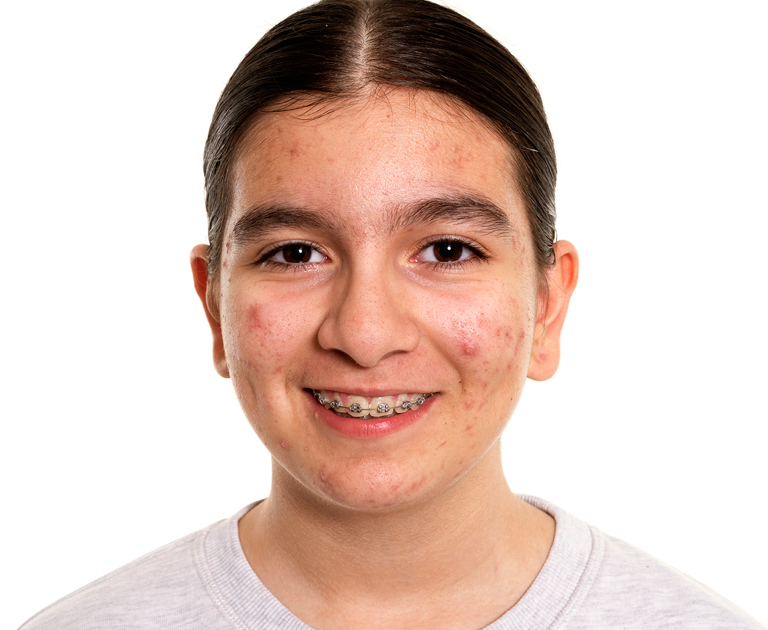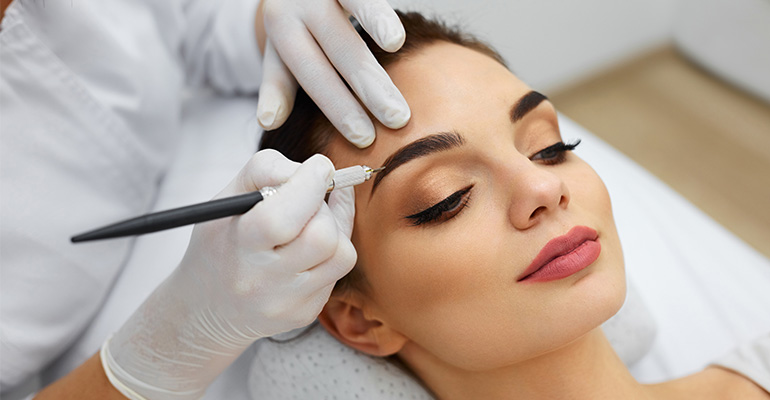Acne can strike at any time, not only flaring up your skin but also feelings of embarrassment or low self-esteem.
While you might assume making it through your teen years gives you a hall pass for clear skin, that isn’t the case. Acne can affect anyone of any age.
Whether your acne made its debut at 13 or 30, we can help you find a way to reclaim your glow.
What’s Acne and When Does It Start?
Acne is a skin condition that’s most common in teenagers but can also affect adults. It’s caused by oil and dead skin cells clogging your pores—much like your hair can clog up a drain. Whiteheads and blackheads are clogged pores without infection. Pimples, pustules, nodules, and cysts are inflammatory types of acne. When this type of acne starts, it can cause painful and red or pus-filled lumps in your skin.
Does Acne Go Away After Puberty?
The short answer is sometimes, not always. There are a few differences between teenager acne and adult acne, but let’s start with the similarities. Both types of acne are caused by a build-up of oil and dead skin cells with or without inflammation, and both can be triggered by hormonal changes. The differences are to do with the resilience of your skin and where the acne is likely to occur. Let’s take a closer look at both.
Teen Acne
If you’re wondering when does acne start, for most people, it will be during their teen years. shows up to 93% of people have acne during their teen years. This isn’t necessarily comforting when feelings of low self-esteem are making it hard to face school or even hang out with friends.
But before we skip to teenage acne treatments, let’s first understand why your acne occurs.
During puberty, your body goes through hormonal changes. Androgens, like testosterone, are the hormone type that could be causing your acne. When androgens increase, they also increase the size of oil-producing glands: more oil = more blemishes. Acne in teenagers usually occurs on the T-zone, across your forehead, nose and cheeks.
The great news for anyone wanting to know how to get rid of your teenage pimples is that when your hormones level out after puberty, your acne may go away. And because your skin replenishes more quickly than adult skin, any marks left on your face could fade away faster than someone older.
Adult Acne
Although adults are less likely to develop acne, it’s impossible to know how long adult acne will last. Like teenagers, your inflamed skin is caused by excess oil production and may be the result of hormonal or genetic factors. Women are more likely to experience acne than men with pregnancy and menstruation (and the hormonal changes that go with it) are common triggers.
Unfortunately, growing up doesn’t mean we grow out of feeling embarrassed about our skin. Adult acne can have a similar effect on your self-esteem as if you’re a teenager. It’s hard to face a Zoom room of colleagues or a first date when all you can think about is if they can see your cystic acne underneath plaster-like makeup.
Acne in adults is more likely to occur on your chin and along your jawline. Your adult skin is also facing a few extra obstacles because it’s drier and slower to replenish skin cells. It’s vital that you stay on top of your skincare routine for acne, as recovery is likely to be slower than if you were a teenager.
However, with the right products and plan in place, there’s no reason you can’t achieve and maintain that irresistibly soft, clean-feeling skin year after year.
What Causes Acne Scars?
Even once a breakout is back under control, you can still be left with scars. You may also have discolored patches of skin known as hypopigmentation and hyperpigmentation.
The most important thing to remember is to not pick at your acne while it’s active. Easier said than done, we know, but it plays a major role in how your skin looks after the outbreak has subsided.
When treating acne, look for a solution that also tackles these secondary concerns for your best chance at flawless skin.
How to Treat Acne
There are several acne treatment options available to anyone with teenager acne or adult acne. Acne treatments commonly include topical solutions and/or medication. But there are another effective acne treatment aestheticians turn to for their patients: Dermapen Treatments™.
Dermapen Treatments for acne are a holistic solution that involves several micro-needling sessions using a Dermapen and a daily skincare routine using Dp Dermaceuticals products rich in acne-fighting ingredients, including:
Glycolic Acid: A water-soluble exfoliant that helps your skin shed skin cells. Of all the AHAs, Glycolic Acid has the smallest molecule, so it can penetrate deeper.
Salicylic Acid: This oil-soluble exfoliant can penetrate lipid layers between skin cells to unclog pores and target acne at the source.
Retinoids: Keep pores clear to prevent acne from occurring and minimize other signs of aging.
Niacinamide: Vitamin B3 is proven to improve acne and acts as an anti-inflammatory to calm and soothe irritated skin.
Tyrannise Inhibitors: Stop the production of melanin and fade existing spots and patches.
Microneedling for Acne
Dermapen Treatments are suitable for both teenagers and adults with acne. It’s a natural acne treatment that really works by stimulating your body’s own renewal and repair function. It boosts the production of collagen and elastin, oxygenates the skin and encourages lymphatic drainage.
A Dermapen Treatment doesn’t just blast acne but also:
Targets acne scarring from previous breakouts
Minimises current and future pigmentation
Hope for clear healthy-looking skin is possible. Whether your acne has just started, or you’ve tried every acne treatment on the shelf, Dermapen Treatments can offer real results.
Achieve Your Skin Goals
There’s no better feeling than when your skin goals become a reality. Unfortunately for so many teens and adults, those goalposts sometimes feel like a speck on the horizon. With Dermapen Treatments for acne, clear glowing skin is within reach.











